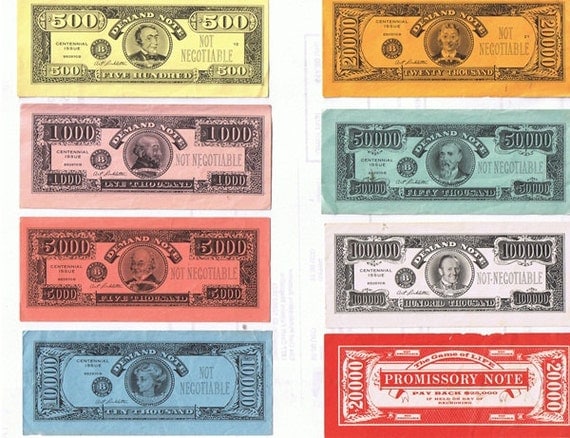The DU Lounge
Related: Culture Forums, Support ForumsAlthough 42,000 were printed, only 12 remain in existence and it's illegal to own one.

The 100,000 Dollar Bill
True Dough
(19,033 posts)can you make change for $100,000?
![]()
ProfessorGAC
(68,460 posts)I only have big bills! ![]()
magicarpet
(15,830 posts)... but it is a by-ee-itch finding someone to break it down into smaller change.
ColinC
(9,941 posts)Different reason, but similar purpose
Think. Again.
(15,684 posts)GreenWave
(8,491 posts)
Groundhawg
(804 posts)DFW
(55,941 posts)The $100,000 notes were only printed and intended for internal transactions of the Federal Reserve. I don't know if one has ever been seized from a private collector, or, if so, how a collector could have obtained one.
On the other hand, over 400,000 1933 $20 coins were minted and intended as legal tender. They were never officially released, but were available at the "collector's window" of the Philadelphia mint, where people could go and exchange $20 gold coins from previous years for new one, giving a "tip" to the mint employee. It was a standard "be the first on your block to own one" practice, but it turned into an issue when the order came down not to release the coins. Dozens of the coins left the mint, but the employees suddenly denied the practice, adopting a "who? me? never!" attitude, since it was never officially sanctioned. Since the coins were replaced with other $20 gold coins, the government never missed any gold. It only became an issue after a collector who worked for the Secret Service was unable to obtain one, and, out of revenge, got the government to declare them illegal to own. This was years after 1933. During World War II, King Farouk of Egypt, an ally of the USA and avid coin collector, wanted to buy one from a New York coin dealer. The dealer, not wanting to run afoul of the government during wartime, sent the coin to Washington, requesting an export permit, so that he could sell it to King Farouk. The government sent the coin back with the required export permit, and the coin was sent to Farouk. That particular coin showed up in the 1990s, when an English coin dealer with ties to Egypt sold it in London, and it was brought to the USA and seized by the Secret Service as "stolen US Government property." The British dealer who had brought it to the USA sued to get it back, and his lawyer found the government export permit in the National Archives. The "stolen" argument fell flat with that, and it was auctioned off in 2002, with the Treasury and the British dealer splitting the proceeds. Ten more were found in 2004 the inventory of an old Philadelphia dealer. They were rolled up in paper with some silver dollars, and his family never bothered to assume they were anything else until a thorough inventory decades later. The family declared them to the government, who seized them, but never brought any charges, as the family never knew what they had. They sued to get them back, but lost the case, since no documents supporting legal ownership ever showed up. The cashier at the Collectors Window in 1933 never gave out receipts, since he pocketed the 25 cent per coin tip for himself. In 1933, it wasn't the best of times to find yourself unemployed.
Trivia story of the day!
Groundhawg
(804 posts)It isn't illegal to own one. I seen one on display at Binion's horseshoe in vegas years ago.
DFW
(55,941 posts)If the Fed never released them, and only used them for internal transactions, how could one be on display unless it was on loan from the government? The government does sometimes loan things like that for exhibitions, but they just relinquish posession for the exhibition, not ownership. And $10,000 bills are already legal to own, although I doubt presenting one at your local CVS and hoping for change would get you very far.
Polybius
(16,878 posts)Perhaps it was illegal for a time, but that's long since expired? Jut guessing here.
DFW
(55,941 posts)The British guy was arrested (quickly released, but the legal wrangling took 6 years) with the Farouk 1933 $20 in 1996. Treasury has stated they would seize any further ones that show up, and indeed, did seize the ten pieces from the Langbord family in Pennsylvania in 2004. The story behind them was pretty wild. A coin and jewelry dealer in the Philadelphia area named Israel Switt bragged that he had exchanged older coins for 25 pieces of 1933 dated coins in early 1933--after minting, but before the release date. He had died by the time the big confiscation got started in the 1940s, and since he was known for having a big mouth, everyone just assumed he had exaggerated the number of 1933 coins he had. Fifteen collectors he had sold the coins to surrendered their examples, and the Secret Service just gave up and assumed that's all that he really ever had. After all, they really have more important duties than chasing down ten coins that hadn't even been stolen, since $20 gold coins had been exchanged for a like amount of $20 gold coins. When the government finally melted down the ones they had, not a gram of gold was missing, so they just assumed all outstanding pieces had been accounted for.
But the fact that they bothered to make a seizure in 2004 indicates that they would probably seize others, if they should surface (rumors always abound, although no one has offered one for sale that I have heard of). Chasing after these things seems like a waste of the government's time to me, but I gave up trying to figure out the mentality of the government bureaucrat long ago.
zanana1
(6,250 posts)JoseBalow
(4,418 posts)